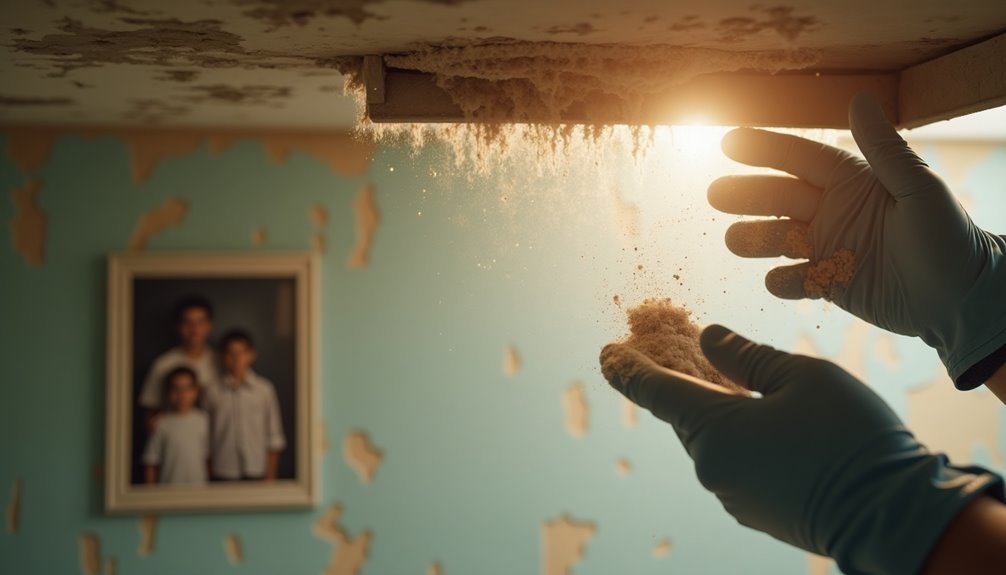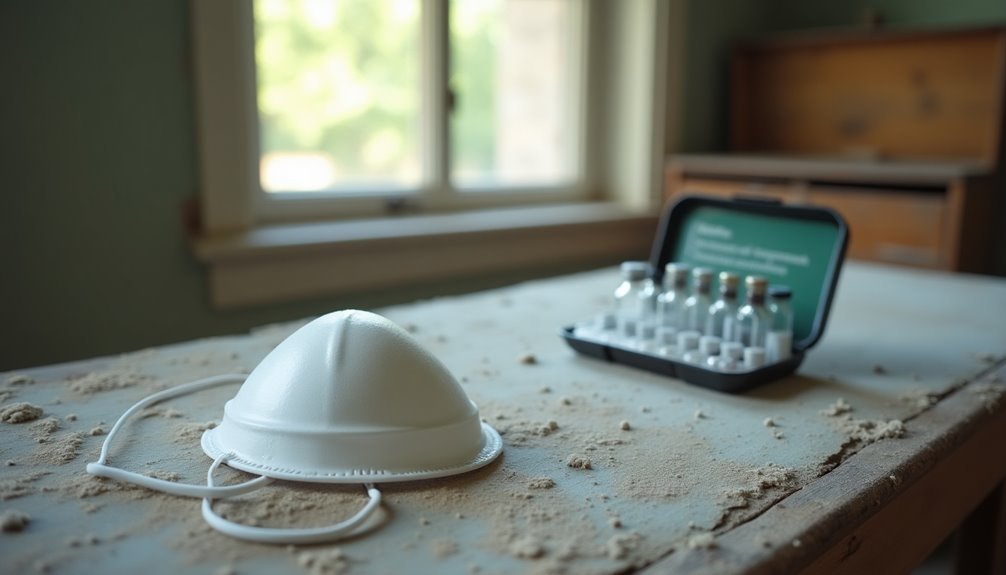Asbestos poses serious health risks, including asbestosis, lung cancer, and mesothelioma. Inhalation of its fibers can lead to lung tissue damage, often with symptoms appearing decades later. Renovations in older homes and working on older vehicles are common exposure sources. To protect your family, professional abatement services are crucial. They follow strict safety protocols, contain the area, and ensure proper removal and disposal of asbestos materials. Qualifying for effective abatement hinges on accurate testing and regulatory compliance. Understanding these processes is vital for maintaining your home's safety and well-being. Let's explore how you can better safeguard your living environment.
Health Risks of Asbestos

Many people may not realize the severe health risks associated with asbestos exposure. Asbestos can lead to debilitating diseases, including asbestosis, mesothelioma, and lung cancer. When you inhale asbestos fibers, they can become lodged in your lung tissue, causing scarring and inflammation. Over time, this damage may escalate into serious conditions, and the symptoms often remain hidden for decades—sometimes 20 to 50 years. Early exposure symptoms may seem vague, manifesting as persistent coughing or shortness of breath, which can easily be mistaken for less serious issues.
The link between asbestos and various cancers is alarming. Not only does exposure increase your risk of lung cancer, especially if you're a smoker, but it's also associated with cancers of the digestive system, including colon cancer. The risk is dose-related, meaning the more fibers you inhale, the greater the likelihood of developing asbestos diseases. With nearly 1,300 Americans dying from these conditions each year, it's critical to understand the long-term consequences of exposure. All asbestos fibers are harmful if breathed, making awareness your first step toward liberation from these hidden dangers.
Common Asbestos Exposure Sources
Understanding the health risks associated with asbestos exposure highlights the importance of identifying common sources of this hazardous material. One significant source in your home is during renovations. If you're working on older structures, keep an eye out for attic and wall insulation, particularly vermiculite, which often contains asbestos. Disturbing drywall, ceiling tiles, or textured paint during your projects can release dangerous fibers into the air.
Automotive repairs also pose a risk, especially with older vehicles. Brake components frequently contain asbestos, and replacing them can scatter harmful fibers. Using compressed air to clean these parts further exacerbates the issue. If you're engaged in DIY auto repairs, be aware that drilling or sanding could release toxic fibers into your home environment.
Additionally, consider environmental sources. Gardening in areas with naturally occurring asbestos or living near facilities that handled asbestos increases your risk. Over 50% of mesothelioma patients diagnosed annually in the U.S. are impacted by these risks. Understanding these exposure sources empowers you to take precautions, ensuring your family stays safe from the dangers of asbestos. Always opt for professional help when dealing with suspected asbestos materials to mitigate these risks effectively.
Asbestos Detection and Testing

When it comes to ensuring a safe environment, testing for asbestos is crucial. Understanding the various sampling methods, such as Polarized Light Microscopy and Transmission Electron Microscopy, can help you choose the right approach for your situation. Once you have your results, interpreting them accurately is essential for making informed decisions about abatement and safety measures.
Importance of Testing
Accurate testing for asbestos is vital in safeguarding health and ensuring compliance with regulatory standards. Without it, you risk exposing yourself and your loved ones to hazardous fibers that can lead to severe health issues, including mesothelioma. Various testing techniques, such as phase contrast polarized light microscopy (PLM) and transmission electron microscopy (TEM), provide precise identification of asbestos materials. PLM evaluates fibers based on optical properties, while TEM analyzes their chemical composition and structure.
Utilizing accredited laboratories ensures that testing meets UKAS standards and HSG 248 guidelines. Analysts must be qualified, which adds an extra layer of reliability to the process. This diligence not only protects your health but also ensures legal compliance, preventing potential liabilities.
The benefits of thorough testing extend beyond safety; they can also lead to cost savings in the long run. By accurately identifying asbestos, you can make informed decisions about remediation, potentially reducing the overall costs of abatement. Investing in proper testing techniques not only liberates you from health risks but also empowers you to take control of your environment, ensuring a safer future for you and your family.
Sampling Methods Explained
To ensure reliable asbestos detection, employing proper sampling methods is crucial. First, make sure a qualified person conducts the sampling, someone trained and experienced in this sensitive task. They should wear protective gear, including a fitted respirator, to minimize exposure. Begin by lightly misting the area where you'll collect samples to reduce fiber release. It's vital to minimize disturbance and isolate the area during the process.
For sample collection, take a small piece—about 1 to 2 square inches—using appropriate tools like a knife or chisel. Collect all layers of materials like roofing or insulation, and place the sample in a clean, sealable plastic bag. Seal the bag securely and label it with pertinent information.
Once samples are collected, analysis methods come into play. Techniques like Polarized Light Microscopy (PLM) and Transmission Electron Microscopy (TEM) are common for determining asbestos content. These methods help identify fibers accurately, ensuring the safety of your environment. By following these guidelines, you empower yourself to make informed decisions regarding asbestos hazards in your home.
Interpreting Asbestos Results
Interpreting asbestos results is a critical step in understanding your environment's safety concerning asbestos exposure. You'll want to familiarize yourself with the analytical techniques used to identify asbestos fibers in your samples. Various methods exist, each with its advantages. Here are some key points to consider:
- Phase Contrast Polarized Light Microscopy (PLM): Ideal for initial identification, it analyzes fiber morphology and optical properties.
- Transmission Electron Microscopy (TEM): Offers detailed fiber analysis, distinguishing between crystalline and amorphous fibers, even those smaller than 0.1 µm.
- Scanning Electron Microscopy (SEM): Provides a quicker, field-friendly alternative for identifying fibers based on chemical composition and appearance.
When interpreting results, pay attention to the morphology, color, and pleochroism of identified fibers. Each method contributes to a comprehensive understanding of asbestos fiber identification, allowing you to make informed decisions about your environment's safety. Always ensure that results are documented properly and stored according to regulations. Armed with this knowledge, you can better protect your family against potential asbestos hazards.
Abatement and Removal Processes
When it comes to abatement and removal processes, understanding safe removal techniques is crucial for protecting yourself and others. You'll need to ensure compliance with regulatory measures to maintain safety and legality throughout the project. By following these guidelines, you can effectively manage asbestos hazards while minimizing risks.
Safe Removal Techniques
Safe removal techniques for asbestos are crucial in mitigating the health risks associated with this hazardous material. By employing effective removal methods and containment strategies, you can ensure a safer environment for your family. Here are key steps to consider during the abatement process:
- Preparation and Planning: Develop a detailed abatement plan that outlines the scope of work, containment measures, and safety protocols.
- Containment and Isolation: Seal off the work area with plastic sheeting and use negative air pressure machines to prevent asbestos fibers from escaping.
- Removal Techniques: Wet asbestos materials to minimize airborne fibers, and use hand tools to avoid dust creation.
These techniques not only reduce the risk of exposure but also ensure that any asbestos removal is conducted safely and effectively. Always remember to conduct a comprehensive risk assessment and secure necessary permits before beginning the work. By following these safe removal techniques, you take significant steps toward liberating your home from the dangers of asbestos, protecting both your health and your family's well-being.
Regulatory Compliance Measures
Successfully removing asbestos from your property involves more than just safe techniques; it also requires strict adherence to regulatory compliance measures. You'll need to navigate various regulatory frameworks, which can differ by location. For instance, in Chicago, you must notify the Chicago Department of Public Health at least ten working days before starting any demolition or renovation that involves asbestos. In New York City, this notification is required at least seven days in advance.
Engaging licensed contractors is mandatory, as compliance audits ensure these professionals meet the rigorous training standards set by state health departments. Workers must follow OSHA guidelines and EPA regulations to safely handle asbestos. Regulatory inspections, including unannounced visits, verify adherence to local laws, such as Chicago's Chapter 11-4 regulations.
Post-abatement procedures are equally critical, involving proper disposal of asbestos waste according to the Clean Air Act and NESHAP standards. Clearance testing and air monitoring confirm that the area is safe for re-entry. By understanding these compliance measures, you empower yourself to ensure a safe environment for your family, liberating your home from the dangers of asbestos.
Important Safety Precautions

Handling asbestos-containing materials requires strict adherence to safety precautions to protect yourself and others from harmful exposure. Effective asbestos handling is crucial in preventing fiber release, which can lead to serious health risks. Here are some essential safety measures you should follow:
- Wear appropriate personal protective equipment, including NIOSH-approved respirators.
- Wet down the material before and during work to minimize airborne fibers.
- Use non-powered hand tools to reduce dust generation.
When working with asbestos, always isolate the area and inform those nearby to keep them safe. Avoid cutting or sanding unless absolutely necessary, and apply methods that will minimize fiber release. After completing your work, ensure you clean up effectively using wet mops or HEPA vacuums to avoid spreading any residual asbestos fibers.
Remember to shower and wash your hair immediately after handling asbestos to eliminate any dust. Avoid eating, drinking, or smoking in areas where asbestos may be present. By following these precautions, you not only protect yourself but also safeguard your family from the dangers associated with asbestos exposure.
Regulatory Standards for Abatement
Ensuring the safe management of asbestos goes beyond personal protective measures; it also involves adhering to a framework of regulatory standards designed to safeguard public health. Regulatory bodies like OSHA and the EPA establish essential guidelines, setting permissible exposure limits and overseeing the safe removal and disposal of asbestos-containing materials. At the state level, enforcement mechanisms, such as licensing requirements and notification protocols, further enhance safety.
You'll face compliance challenges when navigating these regulatory frameworks. Each state, including Connecticut and Georgia, has specific regulations that must be followed, including accredited training for workers and project supervisors. Contractors need state-specific licenses, and notifications about abatement projects must be submitted to relevant authorities before work begins.
Proper disposal and waste management are also critical. You must generate Waste Shipment Records for asbestos materials, ensuring they're disposed of according to strict guidelines, including wetting and sealing in leak-tight containers. Understanding these regulations is not just a legal obligation; it's crucial for protecting your family and community from the dangers of asbestos exposure. Adhering to these standards fosters a safer environment for everyone.
Conclusion
So, if you think living in a house with asbestos is just a quirky retro vibe, think again. It's not just a bad '70s hairstyle; it's a ticket to serious health issues. Trust professionals for detection and safe removal, because your family deserves more than a game of "guess that fiber." As you navigate this hazardous maze, remember: safety first, nostalgia second. Don't let your home be a ticking time bomb of bad decisions—get those abatement services on speed dial!
